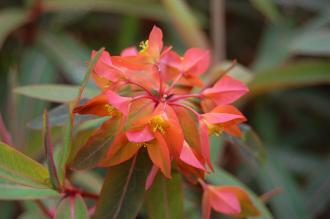
Euphorbia griffithii ‘Fireglow’ Flower (05/05/2012, Kew Gardens, London)
Position: Full sun to partial shade
Flowering period: Late spring to early summer
Soil: Moist, well drained
Eventual Height: 90cm
Eventual Spread: 60cm
Hardiness: 4a – 9b
Family: Euphorbiaceae
Euphorbia griffithii ‘Fireglow’ is a fast growing deciduous herbaceous perennial . Its dark green leaves are lanceolate to linear with entire margins, arranged around erect stems, are tinged with pink at its edges and midribs and are up to 15cm long. In autumn its leaves turn shades of red to yellow before falling. Its flowers are a combination of petals and bracts and are orange/ red and appear at the ends of the stems. Its roots are rhizomes which aids its spread.
The species Euphorbia griffithii, commonly known as Griffith’s Spurge or just Spurge (a name given to the entire Euphorbia genus), is native to the Himalayas. In its native habitat it is found in forest margins, scrub and meadows. Care should be exercised when handling this plant as its sap may irritate the shin of some people.
The etymological root of the binomial name Euphorbia derives from Euphorbus, after the name of the Greek physician of King Juba II of Numidia. Griffithii is named after the British doctor and botanist William Griffith (1810-1845).

Euphorbia griffithii ‘Fireglow’ (05/05/2012, Kew Gardens, London)
The landscape architect may find Euphorbia griffithii ‘Fireglow’ useful a colourful deciduous plant for a shady location. Once established this plant is drought tolerant.
Ecologically, E. griffithii ‘Fireglow’ is attractive to pollinating insects.
E. griffithii ‘Fireglow’ prefers moist, humus rich, well-drained soils. It tolerates most pH of soil.
Euphorbia griffithii ‘Fireglow’ requires little maintenance. Flowering shoot may be cut to ground level in autumn to keep a tidy appearance. Large clumps may be divided in spring.

